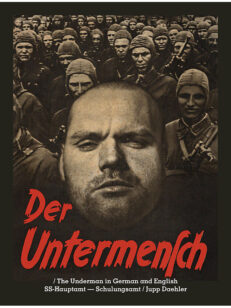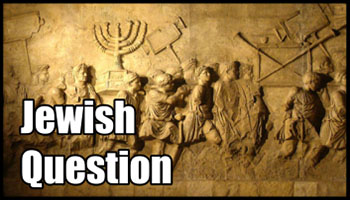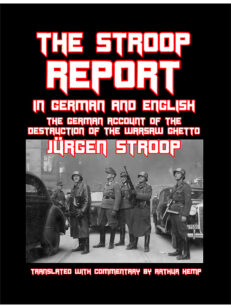Description
By Jurgen Stroop. Translated, annotated and introduced by Arthur Kemp. The Stroop Report is the official German account of the destruction of the Warsaw Ghetto from April to May 1943, prepared by the Commanding Officer of the operation, SS-Brigade Leader Jürgen Stroop.
Divided up into three sections—an executive summary, copies of the official day-to-day combat reports, and a photographic record, the report contains a number of fascinating insights into the brief and brutal conflict:
- The Warsaw Ghetto contained a large number of factories in which the Jews worked—and many of these factories were vital to the German war effort.
- The decision to relocate these factories—and their workers—to Lublin (and the Majdanek concentration camp) was opposed by the Jews in Warsaw, and served as the spark for physical resistance to the Germans.
- The Jewish residential area was up to that time fully under the control of the elected Jewish Council, and the German forces only intervened in Ghetto affairs when German interests were affected.
- The Jewish Council had its own police force, complete with armbands and military-style caps, with which it maintained law and order within the Ghetto walls.
- Under instruction from this Jewish Council, the Jews working in the armaments factories in the Ghetto started building a series of interconnected underground bunkers in 1942. They told the Germans they were constructing air-raid shelters.
- Two previous German attempts to relocate the Jews of Warsaw had succeeded in emptying the Ghetto of more than two-thirds of its inhabitants.
- The ferocity of the Jewish resistance initially caught the German forces unaware, and the head of the SS in Warsaw was replaced after the first day by Heinrich Himmler, who ordered Stroop in to suppress the uprising.
- Stroop’s first course of action was to close down all the armaments factories within the Ghetto which had been supplying the Jewish forces with weapons and explosives. The extent of the Jewish autonomy within the Ghetto was revealed when Stroop discovered that some of the factory buildings had even been fortified with concrete to become nearly impenetrable forts.
- Once the factories were closed down, and relocated to the greater Lublin area along with their workers, Stroop’s forces started combing the Ghetto block by block, looking for bunkers and engaging in ongoing street guerrilla warfare until the last Jewish resistance centers were uncovered and broken.
- The Germans were actively supported in this operation by SS-Auxiliaries recruited from former Russian Army soldiers (the “Trawniki Men”) who were drawn from Ukrainians and ethnic Russians. The Stroop Report also describes these forces as “Askaris.”
- In addition, the action to remove the Jews from Warsaw was actively supported by the majority of the local Polish population. Polish police took an active part in the “large-scale action” and also suffered casualties from combat with the Jewish resistance.
- Polish police also actively helped apprehend Jews who had escaped the Ghetto fighting, and eagerly availed themselves of an offer by Stroop to take one-third of whatever money or riches the apprehended Jews possessed.
- Throughout the report, Stroop repeatedly refers to the Polish parts of Warsaw as the “Aryan” sections of town—indicating what can only be an official change in German policy regarding the racial make-up of Poland.
- The approximately 42,000 Jews captured alive in the Ghetto fighting were transported by train to the Treblinka concentration camp. From the Stroop Report, it is clear that the majority of Jews from Warsaw were ultimately moved to Lublin, where the Ghetto factories had been relocated.
This edition contains the original German pages alongside full English translations, and also contains all 70 original photographs, many of which are published here for the first time ever.
232 pages. 8.5″ x 11″. Paperback.



























